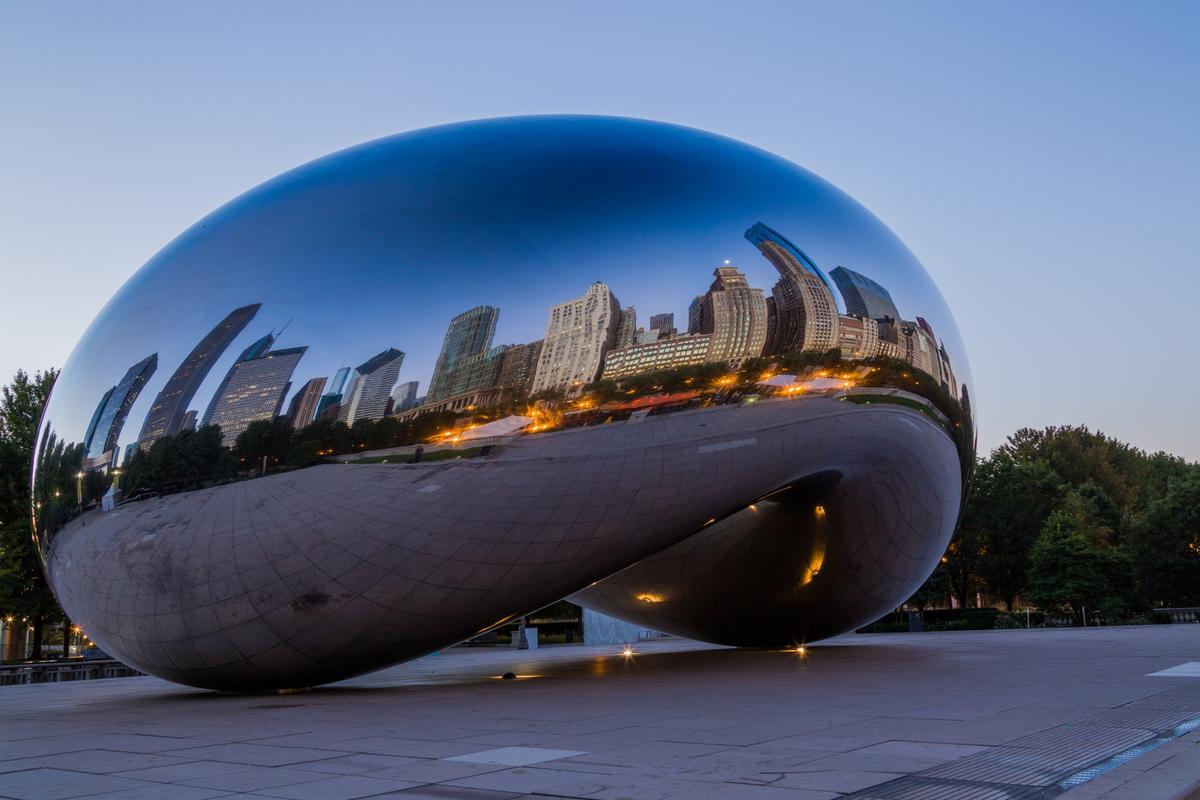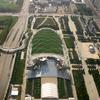More about Cloud Gate

Contributor
Cloud Gate has become the Windy City’s most esteemed piece of public art.
Perhaps it is so dearly loved for its canny capacity to echo Chicago’s iconic skyline, or maybe it’s reflective surface just appeals to the narcissist within, either way we love it! Consisting of 110 tons of seamless shiny stainless steel, this work is actually Anish Kapoor’s first public outdoor work that was installed in the US. Naturally, with the immense success of Cloud Gate, Kapoor’s career has yet to falter even with the hefty price tags the come with his work. Originally, they estimated that Cloud Gate would cost a measly $6 million but you know how that always goes and needless to say the price point jumped a wee bit up to a cool $23 million. But now Chicago has a piece of public art the draws tourists from around the world. Chicagoans have even playfully nicknamed this work, The Bean, which the refined and serious Kapoor finds completely stupid.
Cloud Gate is the result of a design competition held by the City of Chicago to liven up the new Millennial Park that was in the works. Fellow artist Jeff Koons applied as well with a proposal to erect a giant 150ft tall playground with a 90ft tall observation deck and slide that people could use to get back to the ground. Unfortunately for old Koonsy, the city felt the mammoth structure was not grand enough and decided on Kapoor’s much more subtle and tasteful design. Upon its victory, many naysayers felt the design was just a pipe dream that could never actually be constructed. Rife with potential for technical hiccups, such as being a landing pad for bird poop, graffiti, and fingerprints, Kapoor and the city decided to move forward and prove all those who doubted them wrong. And prove they did, for Cloud Gate is considered one of the biggest tourist attractions in the city, bird poop and all!
That said, the city is not too fond of this piece being a receptacle for droppings and vandalism, so naturally Cloud Gate has become a pretty high maintenance piece of art as well. It requires a twice daily cleaning to rid it of onlookers' greasy touch, a nightly powerwashing session to free it of other grime and bird poop, and a twice annual deep cleaning. It's a lot of work, but at least you know this work will deliver a flawless surface for which to capture that iconic selfie that all visitors must take when visiting the work.
Considering how much attention this thing gets, it comes as no surprise that China has decided to make a knockoff of its own. In the Western oil town Karamay, they recently erected an almost identical sculpture to Cloud Gate. The representative for the project claims that any similarity between the two works is purely coincidental...even though they look exactly the same. Needless to say, Kapoor is not pleased about this one and is pursuing legal action over plagiarism. Kapoor even asked the mayor of Chicago to stand with him on this issue, yet the politico and Kapoor clearly did not see eye to eye on this controversy. The mayor called upon the old saying “imitation is the highest form of flattery” to weasel his way out of becoming caught up in the whirlwind of the legal headache that was bound to ensue. Probably a good choice, it seems like politicians already have enough to worry about these days.
Sources
- Millennium Park - Art & Architecture, https://www.cityofchicago.org/city/en/depts/dca/supp_info/millennium_pa…
- Chicagoist, http://chicagoist.com/2015/09/17/photos_how_the_bean_was_constructed.ph…
- Mental Floss, http://mentalfloss.com/article/79961/9-reflective-facts-about-chicagos-…
- Hyperallergic, http://hyperallergic.com/287628/anish-kapoor-coats-cloud-gate-in-the-da…
- Wall Street Journal, http://blogs.wsj.com/chinarealtime/2015/08/12/a-cloud-gate-in-china-xin…
- Time, http://time.com/3995636/anish-kapoor-bean-china-cloud-gate-xinjiang/
- Artnet News, https://news.artnet.com/art-world/anish-kapoor-criticizes-chicago-mayor…
Featured Content
Here is what Wikipedia says about Cloud Gate
Cloud Gate is a public sculpture by Indian-born British artist Anish Kapoor, that is the centerpiece of AT&T Plaza at Millennium Park in the Loop community area of Chicago, Illinois. The sculpture and AT&T Plaza are located on top of Park Grill, between the Chase Promenade and McCormick Tribune Plaza & Ice Rink. Constructed between 2004 and 2006, the sculpture is nicknamed "The Bean" because of its shape, a name Kapoor later grew fond of. Kapoor himself even uses this title when referring to his work. Made up of 168 stainless steel plates welded together, its highly polished exterior has no visible seams. It measures 33 by 66 by 42 feet (10 by 20 by 13 m), and weighs 110 short tons (100 t; 98 long tons).
Kapoor's design was inspired by liquid mercury and the sculpture's surface reflects and distorts the city's skyline. Visitors are able to walk around and under Cloud Gate's 12-foot (3.7 m) high arch. On the underside is the "omphalos" (Greek for "navel"), a concave chamber that warps and multiplies reflections. The sculpture builds upon many of Kapoor's artistic themes, and it is popular with tourists as a photo-taking opportunity for its unique reflective properties.
The sculpture was the result of a design competition. After Kapoor's design was chosen, numerous technological concerns regarding the design's construction and assembly arose, in addition to concerns regarding the sculpture's upkeep and maintenance. Various experts were consulted, some of whom believed the design could not be implemented. Eventually, a feasible method was found, but the sculpture's construction fell behind schedule. It was unveiled in an incomplete form during the Millennium Park grand opening celebration in 2004, before being concealed again while it was completed. Cloud Gate was formally dedicated on May 15, 2006, and has since gained considerable popularity, both domestically and internationally.
Check out the full Wikipedia article about Cloud Gate












